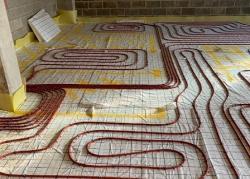Why underfloor heating is a great choice for low carbon systems
 In most houses, a large part of the energy consumption is for the heating and so choosing a low carbon system is not only the most sustainable option but can also the most cost-effective option too.
In most houses, a large part of the energy consumption is for the heating and so choosing a low carbon system is not only the most sustainable option but can also the most cost-effective option too.
Why low carbon heating
Low carbon heating will have lower running costs than traditional non-renewable fuels, however installation can be expensive. This can make them difficult to justify on a cost basis overall. As part of its pledge to achieve net zero carbon emission by 2050, the UK has a number initiatives which may make a low carbon heating system more attractive to home owners in the long run. The government’s new green grants scheme offers financial incentives for anyone choosing to switch from a traditional gas boiler to a more eco-friendly alternative. The ongoing renewable heat incentive is also a scheme that provides financial incentives to support renewable heating systems. With the government also stopping the installation of new gas boilers from 2025, renewable and low carbon systems look set to become a much more popular choice for home-owners of the future.
What low carbon heating sources are available?
There are a number of different low carbon heat sources to choose from. Each has its own pros and cons.
Air source heat pumps extract heat from the outside and air and can extract heat in temperatures as low as -15°. They will use electricity to work the pump and in conjunction with a correctly designed system overall the heat output is greater than the electricity input.
Ground source heat pumps extract heat from the ground using pipes buried in the ground. They are considered an efficient low carbon heat source however they deliver lower levels of heat over longer periods of time than a traditional boiler. They also require energy or electricity to work the pump. For both ground and air source heat pumps space is required inside and outside of the home.
Wood heating or biomass heaters as they are also referred use burn chips, pellets or logs and are usually a cost-effective heat source. Whilst burning wood does release carbon dioxide it is approximately the same amount that was absorbed by the tree during the time that it was growing. There are also emissions associated with the cultivation, processing and transportation of wood but these can be minimised by wood that is locally produced.
Solar thermal power can heat water and also power underfloor heating (using a wet system). Solar PV panels convert solar energy into electricity which can be used to power the appliances around the home including underfloor heating. Solar panels are only able to generate renewable energy in daylight, however the power can be stored in a solar battery for use when the solar panels are not generating heat. The effectiveness of solar panels will depend very much on which way the roof faces and installation will also require space both inside and outside the house.
Micro CHP is not strictly speaking a renewable energy source it does offer a more cost and environmentally friendly choice than standard boilers. Micro CHPs systems use mains gas or LPG to provide heat but also generate electricity at the same time.
Hybrid systems combine renewable technology with a traditional boiler and so will use a combination of renewable and non-renewable heat sources. It will automatically switch between the two systems depending on which is most energy efficient at any given time.
Why use underfloor heating with renewable energy sources?
Whilst all of the different options for renewable heat sources are efficient overall, they do not always provide the high level of heat required at one time to power traditional radiators. In order to ensure the efficiency of the whole system for renewable heat sources such as air and ground heat sources and solar thermal power, heating appliances need to make the most of the heat available and combine with increased insulation to keep the house at a comfortable temperature.
Underfloor heating provides a mix of heat radiated from the floor and convection heat – creating a comfortable and constant temperature between the floor and ceiling. Radiators heat the air which is then moved around the room by convection. As they also have a smaller surface area than an underfloor heating system, greater temperatures are required to achieve a comfortable living environment.
Both underfloor heating and air or ground source heat pumps will work best when left on all of the time. The lag time in heating and cooling of an underfloor heating system means that it does not work best when switched on and off and is best left on at a lower temperature for longer periods of time. Heat pumps are designed to be left on for long periods of time heating water to the lower temperatures that are used by underfloor heating.
Smart control systems can also be installed with underfloor heating systems optimising the usage of heat between different rooms depending on their requirements.
Contact Warmafloor to find out more about how underfloor heating can help to future proof your heating system for a low carbon future.